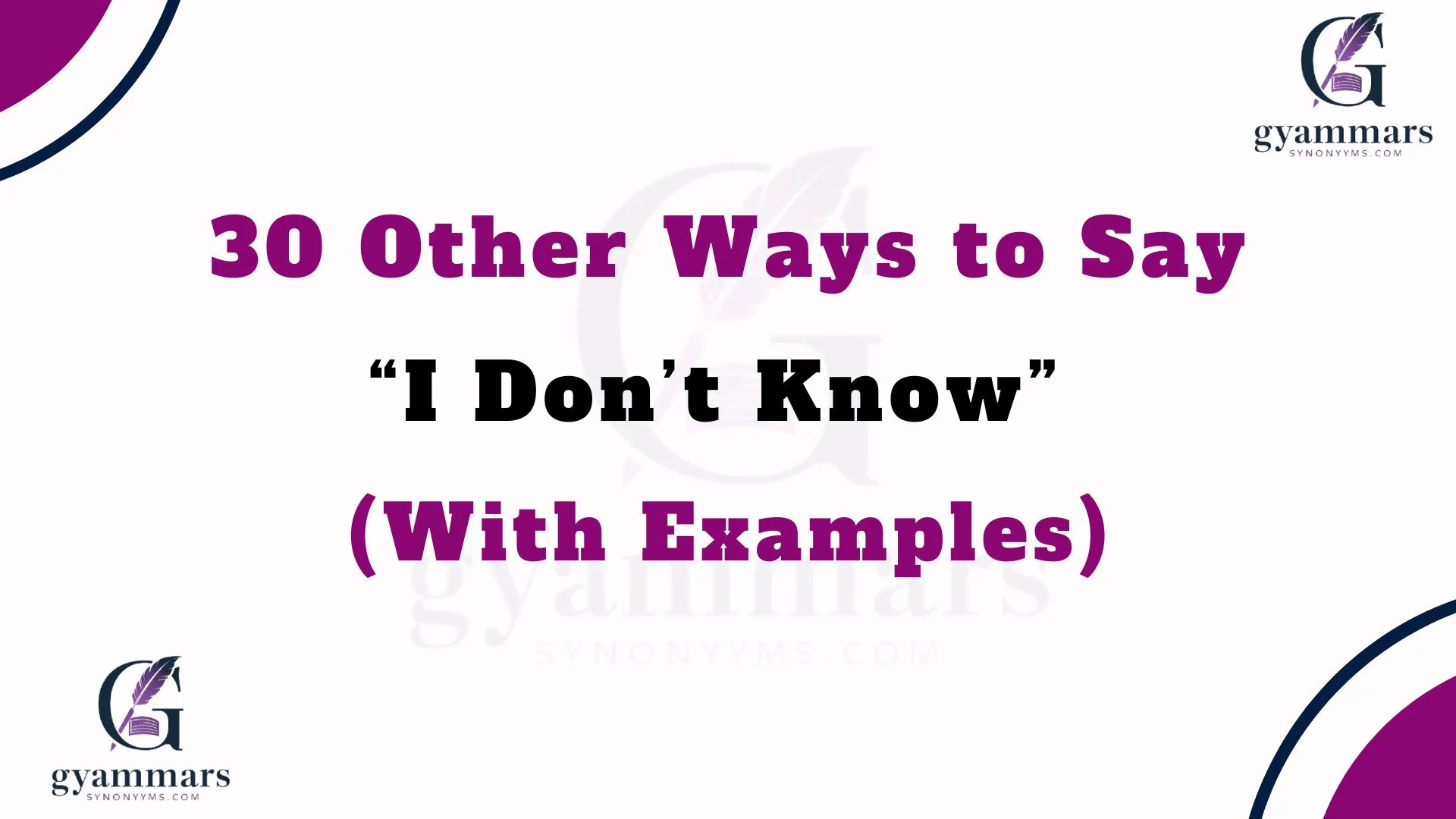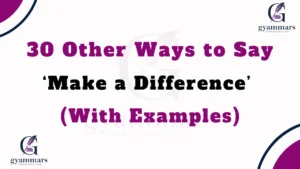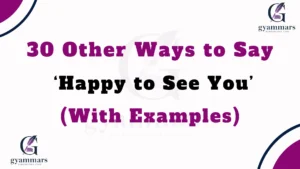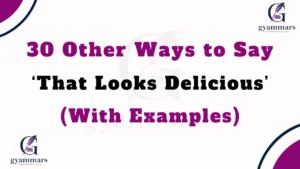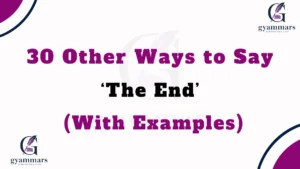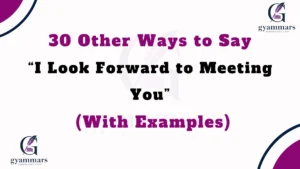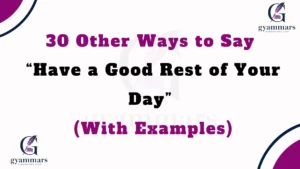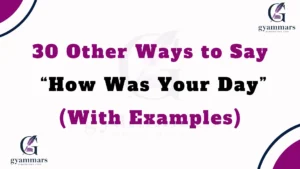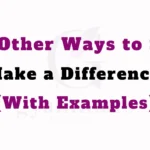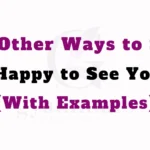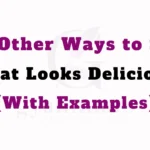Sometimes, simply saying “I don’t know” can feel a bit flat or impersonal. Finding the right words to express uncertainty or lack of knowledge can make a conversation feel more thoughtful and caring. Using alternative phrases can not only soften your message but also show that you’re engaged, reflective, and respectful. Here’s a guide to 30 other ways to say “I don’t know”, along with definitions, examples, and the best ways to use them.
What Does “I Don’t Know” Mean?
Definition: The phrase “I don’t know” expresses a lack of information, certainty, or understanding about a particular topic.
Detailed Explanation: It communicates honesty and transparency but can sometimes feel abrupt or dismissive if not phrased thoughtfully.
Scenario Example:
- A colleague asks about the deadline for a project, and you reply, “I don’t know.”
Best Use: To communicate uncertainty clearly and honestly.
Tone: Neutral, honest.
Additional Notes: Consider pairing it with a follow-up action, like “but I’ll find out.”
Is It Professional/Polite to Say “I Don’t Know”?
Yes, saying “I don’t know” is professional and polite when done correctly. Framing it with follow-up actions or alternative solutions shows responsibility and engagement.
Pros or Cons
Pros: Honest, clear, transparent.
Cons: Can sound abrupt or dismissive if not framed carefully.
Synonyms For “I Don’t Know”
- I’m Not Sure
- I Have No Idea
- I Can’t Say
- I Haven’t the Foggiest
- That’s a Good Question
- I’ll Have to Look That Up
- I’m Not Certain
- Your Guess is as Good as Mine
- I Don’t Have That Information
- I Can’t Help You There
- I’m Not Familiar With That
- I Don’t Have the Answer
- I Haven’t Learned That Yet
- I’m Drawing a Blank
- That’s Beyond Me
- I Don’t Recall
- I Haven’t the Answer
- I Don’t Have the Foggiest Idea
- I’m at a Loss
- I Haven’t Figured That Out
- I Don’t Know Off the Top of My Head
- I’m Not Informed About That
- I Don’t Have Enough Information
- I’m Not Positive
- I Haven’t the Slightest
- That’s Unknown to Me
- I Can’t Answer That Right Now
- I Haven’t Been Made Aware
- I Don’t Know Enough About That
- I’m Unaware
1. I’m Not Sure
Definition: Indicates uncertainty without complete lack of knowledge.
Detailed Explanation: Slightly softer than “I don’t know,” it communicates thoughtfulness.
Scenario Example: “I’m not sure if the meeting is at 3 PM or 4 PM.”
Best Use: Use in professional or casual contexts when you need to convey uncertainty gently.
Tone: Polite, considerate.
Additional Notes: Works well when paired with a follow-up, like “but I can check.”
2. I Have No Idea
Definition: Expresses a complete lack of knowledge.
Detailed Explanation: Stronger than “I’m not sure,” it can sound casual or emphatic.
Scenario Example: “I have no idea how to solve this math problem.”
Best Use: Informal situations or casual conversations.
Tone: Casual, honest.
Additional Notes: Avoid in formal/professional contexts unless paired with a solution offer.
3. I Can’t Say
Definition: Indicates inability to provide an answer.
Detailed Explanation: Suggests discretion or uncertainty.
Scenario Example: “I can’t say if they’ll approve the proposal.”
Best Use: When you want to sound cautious or diplomatic.
Tone: Neutral, reserved.
Additional Notes: Useful in professional settings where speculation is risky.
4. I Haven’t the Foggiest
Definition: Informal, playful way to admit total ignorance.
Detailed Explanation: Adds humor to expressing lack of knowledge.
Scenario Example: “I haven’t the foggiest idea what that abbreviation means.”
Best Use: Casual, friendly conversations.
Tone: Humorous, lighthearted.
Additional Notes: Avoid in serious or professional settings.
5. That’s a Good Question
Definition: A way to acknowledge the question while signaling that you don’t know the answer immediately.
Detailed Explanation: Shows engagement without immediately admitting ignorance.
Scenario Example: “That’s a good question; I’ll need to check.”
Best Use: Professional or educational contexts.
Tone: Thoughtful, polite.
Additional Notes: Can be paired with a promise to follow up.
6. I’ll Have to Look That Up
Definition: Suggests you don’t currently know but will seek information.
Detailed Explanation: Shows initiative and responsibility.
Scenario Example: “I’ll have to look that up before giving you an answer.”
Best Use: Professional or learning environments.
Tone: Professional, proactive.
Additional Notes: Demonstrates willingness to help.
7. I’m Not Certain
Definition: Indicates a moderate level of uncertainty.
Detailed Explanation: Polite and formal way to express doubt.
Scenario Example: “I’m not certain about the final date of the event.”
Best Use: Formal discussions or workplace conversations.
Tone: Professional, polite.
Additional Notes: Slightly more formal than “I’m not sure.”
8. Your Guess is as Good as Mine
Definition: Suggests both parties have an equal lack of knowledge.
Detailed Explanation: Casual, often humorous.
Scenario Example: “When will the package arrive? Your guess is as good as mine.”
Best Use: Informal or playful conversations.
Tone: Lighthearted, humorous.
Additional Notes: Avoid in serious professional discussions.
9. I Don’t Have That Information
Definition: Formal, factual way to admit you lack knowledge.
Detailed Explanation: Neutral and professional, avoids casual tone.
Scenario Example: “I don’t have that information at the moment, but I can find out.”
Best Use: Professional emails, reports, or meetings.
Tone: Professional, neutral.
Additional Notes: Follow-up action is recommended.
10. I Can’t Help You There
Definition: Indicates inability to provide an answer.
Detailed Explanation: Honest but can sound slightly blunt.
Scenario Example: “I can’t help you there; I’ve never dealt with that system.”
Best Use: Casual or professional, when paired with an alternative.
Tone: Neutral, polite if softened.
Additional Notes: Can suggest someone else might help.
11. I’m Not Familiar With That
Definition: A polite admission of lack of knowledge.
Detailed Explanation: Useful in formal or professional contexts.
Scenario Example: “I’m not familiar with that software, but I can learn.”
Best Use: Workplace, interviews, or academic discussions.
Tone: Polite, formal.
Additional Notes: Shows humility and willingness to learn.
12. I Don’t Have the Answer
Definition: Straightforward, honest response.
Detailed Explanation: Neutral and professional, avoids vagueness.
Scenario Example: “I don’t have the answer right now, but I can check.”
Best Use: Professional or academic settings.
Tone: Neutral, responsible.
Additional Notes: Always good to follow up.
13. I Haven’t Learned That Yet
Definition: Indicates current knowledge limitations.
Detailed Explanation: Honest and implies growth mindset.
Scenario Example: “I haven’t learned that yet, but I’m eager to understand it.”
Best Use: Educational or mentorship contexts.
Tone: Polite, positive.
Additional Notes: Encourages curiosity.
14. I’m Drawing a Blank
Definition: Informal, playful way to admit forgetting or uncertainty.
Detailed Explanation: Casual and friendly.
Scenario Example: “I’m drawing a blank on the details of the event.”
Best Use: Conversations with friends or colleagues.
Tone: Casual, lighthearted.
Additional Notes: Can add humor to the conversation.
15. That’s Beyond Me
Definition: Indicates the topic exceeds your knowledge.
Detailed Explanation: Suggests humility.
Scenario Example: “Quantum physics? That’s beyond me.”
Best Use: Informal or reflective discussions.
Tone: Honest, humble.
Additional Notes: Adds personality to your admission.
16. I Don’t Recall
Definition: Polite way to admit forgetting something.
Detailed Explanation: Softer than “I don’t know.”
Scenario Example: “I don’t recall the exact meeting time.”
Best Use: Professional and casual contexts.
Tone: Polite, neutral.
Additional Notes: Can pair with offer to check.
17. I Haven’t the Answer
Definition: Formal and slightly old-fashioned phrasing.
Detailed Explanation: Suggests respectfulness.
Scenario Example: “I haven’t the answer to your question at this time.”
Best Use: Formal letters, speeches, or presentations.
Tone: Polite, formal.
Additional Notes: Rarely used in casual speech.
18. I Don’t Have the Foggiest Idea
Definition: Informal and emphatic.
Detailed Explanation: Expresses total lack of knowledge with emphasis.
Scenario Example: “I don’t have the foggiest idea why this happened.”
Best Use: Casual, humorous conversations.
Tone: Playful, informal.
Additional Notes: Avoid in professional contexts.
19. I’m at a Loss
Definition: Indicates confusion or uncertainty.
Detailed Explanation: Can convey emotional or intellectual uncertainty.
Scenario Example: “I’m at a loss on how to fix this issue.”
Best Use: Professional or personal situations where nuance is needed.
Tone: Thoughtful, reflective.
Additional Notes: Can invite collaboration.
20. I Haven’t Figured That Out
Definition: Suggests active engagement and learning.
Detailed Explanation: Focuses on process rather than failure.
Scenario Example: “I haven’t figured that out yet, but I’m working on it.”
Best Use: Professional or educational contexts.
Tone: Positive, proactive.
Additional Notes: Shows growth mindset.
21. I Don’t Know Off the Top of My Head
Definition: Casual phrase indicating immediate uncertainty.
Detailed Explanation: Suggests willingness to find out.
Scenario Example: “I don’t know off the top of my head, but I can check.”
Best Use: Casual or professional contexts.
Tone: Polite, conversational.
Additional Notes: Encourages follow-up.
Also Read This : 30 Other Ways To Say “Please Disregard My Previous Email” (With Examples)
22. I’m Not Informed About That
Definition: Formal way to admit lack of knowledge.
Detailed Explanation: Suggests professionalism and honesty.
Scenario Example: “I’m not informed about that policy change yet.”
Best Use: Professional settings.
Tone: Neutral, formal.
Additional Notes: Avoid casual usage.
23. I Don’t Have Enough Information
Definition: Suggests incomplete knowledge.
Detailed Explanation: Signals willingness to learn more before answering.
Scenario Example: “I don’t have enough information to provide an answer.”
Best Use: Professional or academic contexts.
Tone: Responsible, thoughtful.
Additional Notes: Often used in decision-making scenarios.
24. I’m Not Positive
Definition: Polite way to indicate uncertainty.
Detailed Explanation: Softer than “I don’t know,” implies slight possibility of knowing.
Scenario Example: “I’m not positive about the meeting schedule.”
Best Use: Professional or casual settings.
Tone: Polite, considerate.
Additional Notes: Can follow with “but I can check.”
25. I Haven’t the slightest
Definition: Informal, expressive way to indicate total ignorance.
Detailed Explanation: Stronger than “I don’t know.”
Scenario Example: “I haven’t the slightest what they meant by that.”
Best Use: Casual or playful conversations.
Tone: Informal, emphatic.
Additional Notes: Use with humor for light conversations.
26. That’s Unknown to Me
Definition: Formal, neutral expression.
Detailed Explanation: Indicates lack of knowledge politely.
Scenario Example: “That’s unknown to me at this point.”
Best Use: Professional correspondence.
Tone: Polite, formal.
Additional Notes: Avoid casual settings.
27. I Can’t Answer That Right Now
Definition: Indicates temporary inability to provide an answer.
Detailed Explanation: Suggests delay rather than ignorance.
Scenario Example: “I can’t answer that right now, but I’ll get back to you.”
Best Use: Professional or formal contexts.
Tone: Polite, responsible.
Additional Notes: Encourages follow-up.
28. I Haven’t Been Made Aware
Definition: Formal, professional phrasing for lack of knowledge.
Detailed Explanation: Indicates absence of communicated information.
Scenario Example: “I haven’t been made aware of any changes to the schedule.”
Best Use: Professional or official communications.
Tone: Neutral, formal.
Additional Notes: Polite and responsible.
29. I Don’t Know Enough About That
Definition: Indicates partial knowledge or insufficient expertise.
Detailed Explanation: Suggests honesty while leaving room to learn.
Scenario Example: “I don’t know enough about that topic to give a proper answer.”
Best Use: Academic, professional, or mentoring contexts.
Tone: Honest, thoughtful.
Additional Notes: Shows humility.
30. I’m Unaware
Definition: Formal, concise admission of lack of knowledge.
Detailed Explanation: Neutral and professional.
Scenario Example: “I’m unaware of the latest updates to the policy.”
Best Use: Emails, reports, or official statements.
Tone: Formal, neutral.
Additional Notes: Can be softened with “but I can check.”
Conclusion
Using alternatives to “I don’t know” can make your responses feel warmer, more thoughtful, and engaging. From casual and playful phrases like “I haven’t the foggiest” to professional ones like “I don’t have the information”, each choice allows you to express uncertainty with care. Remember, pairing these alternatives with follow-up actions or solutions makes them even more effective.
❓ FAQs
Q1. Are there alternatives to saying “I don’t know”?
Yes, you can use phrases like “I’m not sure,” “That’s a good question,” or “Let me find out” to sound more engaging and polite.
Q2. How can I say “I don’t know” in a formal way?
In formal settings, you can say “I’ll need to check on that” or “I don’t have that information at the moment” to keep it professional.
Q3. What are casual alternatives to “I don’t know”?
Casual options include “No idea,” “Beats me,” or “Not sure, honestly.” These sound natural and friendly.
Q4. Can I express “I don’t know” in a positive way?
Absolutely! You can say “I’m curious to learn more about that” or “That’s something I’d like to explore,” which show interest and positivity.
Q5. Why should I avoid saying just “I don’t know”?
Because it may come across as blunt or uninterested. Using alternatives makes you sound more thoughtful, polite, and confident.

“Emma Brooke at Grammar Synonyms is your trusted source for mastering the art of language. Whether you’re looking for the perfect synonym, refining your grammar, or searching for that one ideal phrase, we’ve got you covered. With a wealth of tools and resources, Emma Brooke brings you creative solutions for all your writing needs, making sure your words always hit the mark. Unlock a world of language possibilities and elevate your writing with ease.”
